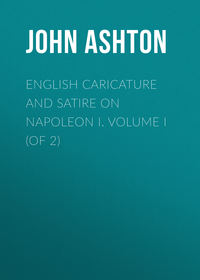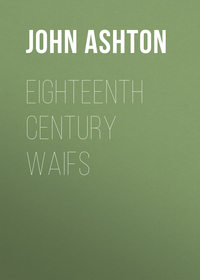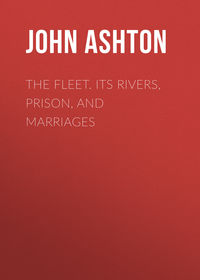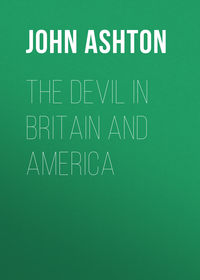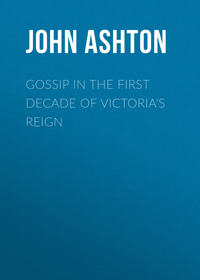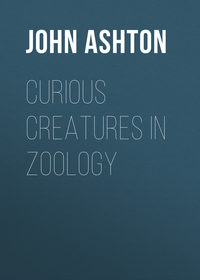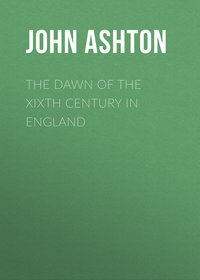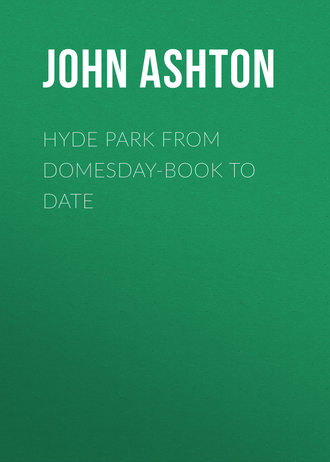
Hyde Park from Domesday-book to Date
Besides Somerset House, the Commissioners had to consider the merits of other sites proposed for the Exhibition, among which may be named Leicester Square, Trafalgar Square, the Isle of Dogs, Battersea Fields, and Regent’s Park; but they selected, after the most careful consideration, that of Hyde Park, and the building occupied a site between the two roads, the eastern end of the building being exactly in the centre of the Knightsbridge Barracks, and its western end reached very nearly to Exhibition Road; and possession of this ground was given to the contractors on 30th July, 1850.
On January 3rd, 1850, a Royal Commission was appointed to carry out the proposed Exhibition, and the following were the members. The Prince Consort, Duke of Buccleugh, Earls of Rosse, Granville and Ellesmere, Lords Stanley and John Russell, Sir Robert Peel, Henry Labouchere, W. E. Gladstone, Sir A. Galloway (or the Chairman of the Court of Directors of the East India Company for the time being), Sir R. Westmacott, Sir Charles Lyell (or the President of the Geological Society for the time being), Charles L. Eastlake, Thomas F. Gibson, Richard Cobden, William Cubitt (or the President of the Institution of Civil Engineers for the time being), John Gott, Samuel Jones Loyd, P. Pusey and William Thompson. They were “to make full and diligent inquiry into the best mode by which the productions of our Colonies, and of foreign countries may be introduced into our Kingdom; as respects the most suitable site for the said Exhibition; the general conduct of the said Exhibition; and, also, the best mode of determining the prizes, and of securing the most impartial distribution of them.” John Scott Russell and Stafford Henry Northcote were appointed joint secretaries, and an executive committee was formed, consisting of Henry Cole, Charles Wentworth Dilke, George Drew, Francis Fuller, and Robert Stephenson, with Matthew Digby Wyatt as secretary.
The story of the building is succinctly told by Sir Henry Cole in his Introduction to the Official Catalogue. “The Committee ventured at once to recommend that upwards of 16 acres should be covered in; a bold step at that time (Feb. 21) when no data whatever of the space likely to be filled had been received. It was their opinion that it was desirable to obtain suggestions, by public competition, as to the general arrangements of the ground-plan of the building, and public invitations were accordingly issued… In answer to the invitation to send in plans, upwards of 245 designs and specifications were submitted… All these plans were publicly exhibited during a month, from the 10th of June, at the Institution of Civil Engineers, Great George Street, Westminster… The Committee reported that, in their opinion, there was no ‘single plan so accordant with the peculiar objects in view, either in the principle, or detail of its arrangement, as to warrant them in recommending it for adoption.’
“They, therefore, submitted a plan of their own; and, assisted by Mr. Digby Wyatt, Mr. Charles Heard Wild, and Mr. Owen Jones, they prepared extensive working drawings, which were lithographed… The Building Committee published in detail the reasons, both of economy and taste, which had induced them to prepare plans for a structure of brick, the principle feature of which was a dome two hundred feet in diameter. Public opinion did not coincide in the propriety of such a building, on such a site, and the residents in the neighbourhood raised especial objections. The subject was brought before both Houses of Parliament; and, in the House of Commons, on the 4th July, 1850, two divisions took place on the question, whether the proposed site should be used at all for any building for the Exhibition. In the one division the numbers in favour of the site were 166 to 47, and, in the second, 166 to 46. The Commissioners published at considerable length a statement of the reasons which had induced them to prefer the site, and there can be no doubt that the force of this document mainly influenced the large majority in both divisions.
“Whilst the plan of the Building Committee was under discussion, Mr. Paxton was led, by the hostility which it had incurred, to submit a plan for a structure chiefly of glass and iron, on principles similar to those which had been adopted and successfully tried by him at Chatsworth. Messrs. Fox, Henderson, and Company tendered for the erection of the Building Committee’s plan, and strictly in accordance with the conditions of tender: they also submitted estimates for the construction of the building suggested by Mr. Paxton, and adapted in form to the official ground-plan. An engraving of Mr. Paxton’s original design was published in the Illustrated London News, 6th July, 1850, which, when compared with the building that has actually been erected, will show what changes were subsequently made. The Commissioners having fully investigated the subject, finally adopted, on the 26th July, Messrs. Fox, Henderson and Company’s tender to construct Mr. Paxton’s building as then proposed, for the sum of £79,800.”
The first iron column was fixed as early as the 26th September, 1850, and the building was ready for opening on May 1st, 1851. It covered an area of 18 acres, was 1850 feet long, 408 feet wide, and 64 feet high, irrespective of the arched roof of the transept; and in order to put it familiarly before people, Mr. Fox, at a dinner given to him at Derby, June 28th, 1851, said, “I walked out one evening into Portland Place; and there, setting off the 1850 feet upon the pavement, found it the same length within a few yards; and then, considering that the building would be three times the width of that fine street, and the nave as high as the houses on either side, I had presented to my mind a pretty good idea of what we were about to undertake.”
It was also part of the contract that the building was removed and the site given up within seven months after the close of the Exhibition, namely before the 1st of June, 1852; which was duly done, and the building re-erected at Norwood, where it still is in existence under the name of the Crystal Palace.
The Mr. (afterwards Sir) Joseph Paxton, who designed the building, was head gardener to the Duke of Devonshire at Chatsworth, where the glass-houses are the wonder and admiration of all who behold them; and he may as well tell the story of how he came to be mixed up with the Great Exhibition, in the same words as he told it at a meeting of the Derby Institute.
“It was not,” said he, “until one morning, when I was present with my friend, Mr. Ellis, at an early sitting in the House of Commons, that the idea of sending in a design occurred to me. A conversation took place between us with reference to the construction of the New House of Commons, in the course of which I observed that I was afraid they would also commit a blunder in the building for the Industrial Exhibition. I told him that I had a notion in my head, and that if he would accompany me to the Board of Trade, I would ascertain whether it was too late to send in a design. I asked the Executive Committee whether they were so far committed to the plans as to be precluded from receiving another; the reply was, ‘Certainly not; the specifications will be out in a fortnight, but there is no reason why a clause should not be introduced allowing of the reception of another design.’ I said, ‘Well, if you will introduce such a clause, I will go home; and, in nine days hence, I will bring you my plans all complete.’ No doubt the Executive thought me a conceited fellow, and that what I said was nearer akin to romance than to common sense.
“Well! this was on Friday, the 11th of June. From London I went to the Menai Straits, to see the third tube of the Britannia Bridge placed, and on my return to Derby, I had to attend to some business in the Board Room, during which time, however, my whole mind was devoted to this project; and whilst the business proceeded, I sketched the outline of my design on a large sheet of blotting paper. Well! having sketched this design, I sat up all night, until I had worked it out to my own satisfaction; and, by the aid of my friend, Mr. Barlow, on the 15th, I was enabled to complete the whole of the plans by the Saturday following, on which day I left Rowsley for London.
“On arriving at the Derby Station, I met Mr. Robert Stephenson, a member of the Building Committee, who was also on his way to the Metropolis. Mr. Stephenson minutely examined the plans, and became thoroughly engrossed with them, until, at length, he exclaimed that the design was just the thing, and he only wished that it had been submitted to the Committee in time. Mr. Stephenson, however, laid the plans before the Committee, and at first the idea was rather pooh-poohed; but the plans gradually grew in favour, and by publishing the design in the Illustrated London News, and showing the advantage of such an erection over one composed of fifteen millions of bricks and other materials, which would have to be removed at a great loss, the Committee did, in the end, reject the abortion of a child of their own, and unanimously recommended my bantling. I am bound to say that I have been treated by the Committee with great fairness.
“Mr. Brunel, the author of the great dome, I believe was, at first, so wedded to his own plan, that he would hardly look at mine. But Mr. Brunel was a gentleman, and a man of fairness, and listened with every attention to all that could be urged in favour of my plans. As an instance of that gentleman’s very creditable conduct, I will mention, that a difficulty presented itself to the Committee as to what should be done with the large trees, and it was gravely suggested that they should be walled in. I remarked that I could cover the trees without any difficulty; when Mr. Brunel asked, ‘Do you know their height?’ I acknowledged that I did not. On the following morning, Mr. Brunel called at Devonshire House, and gave me the measurement of the trees, which he had taken early in the morning, adding, ‘Although I mean to try to win with my own plan, I will give you all the information I can.’ ”
These trees caused a happy modification of Paxton’s plan, and to them we owe the transept, which redeemed the building from being a long and ugly glass shed. As it was, the trees suffered no damage, and really were a very effective feature in the Exhibition. Some other and smaller trees were cut down, which were thus bemoaned by Punch.38
“Albert! Spare those Trees“Albert! spare those trees,Mind where you fix your show;For mercy’s sake, don’t, please,Go spoiling Rotten Row.“That Ride, that famous ride,We must not have destroyed,For, ne’er to be supplied,Its loss will leave a void.“Oh! certainly there mightBe for your purpose foundA more congenial siteThan Hyde Park’s hallowed ground.“Where Fashion rides and drives,House not Industrial Art;But, ’mid the busy hivesRight in the City’s heart.“And, is it thy requestThe place that I’d point out?Then I should say the bestWere Smithfield, without doubt.“There, by all votes approved,The wide world’s wares display,The Market first removedFor ever and a day.”Prince Albert’s academic cap is typical of his being LL.D. and Chancellor of Cambridge; and the singular-looking being addressing him is a staunch and bigoted Tory, whom Punch delighted to caricature, Colonel Charles de Laet Waldo Sibthorp, M.P. for Lincoln, whose opposition to the Exhibition of 1851 amounted almost to mania. Take, for instance, the following quotation from a speech of his in the House of Commons on the subject (26 July, 1850): —
“Hyde Park was emphatically the Park of the People, and it was now proposed to be devoted to purposes which he must hold to be prejudicial to the people in a moral, religious, and social point of view. It was sought to appropriate it to the encouragement of – what? To the encouragement of everything calculated to be prejudicial to the interests of the people. An exhibition of the industry of all nations, forsooth! An exhibition of the trumpery and trash of foreign countries, to the detriment of our own already too much oppressed manufacturers… They were flying in the face of the rights of the public merely to gratify the foreigner, who had no right to be here at all.”
On another occasion he said, “They might call it success, but he called it failure. He did not wish to see that building destroyed by any acts of violence, but would to God that some hailstorm, or some visitation of lightning, might descend to defeat the ill-advised project.” For this he had to sit for his portrait once again. Punch, 15th February, 1851.
On the opening day of the Exhibition, Parliament sat afterwards, at 6 p.m., and, in the course of a debate on the “Oath of Abjuration (Jews) Bill,” Colonel Sibthorp told the House that “He was not present at the Crystal Palace. He felt that his duty to God and his country demanded of him that he should not go there, and he deeply regretted that an eminent prelate of the Church should have been induced to invoke a blessing on that which he (Colonel S.) considered most injurious to the interests of the country and an insult to Almighty God.”
But if Colonel Sibthorp took a pessimistic view of the Exhibition, others held equally optimistic opinions respecting it. It was going to inaugurate a sort of Millennium and a general brotherhood of nations: war was to cease, and all countries were to vie with each other in cultivating the arts of peace. The following song will show the drivel they used to sing about it in the streets.
Crystal PalaceBritannia’s sons an attentive earOne moment lend to me,Whether tillers of our fruitful soil,Or lords of high degree.Mechanic too, and artizan,Old England’s pride and boast,Whose wondrous skill has spread aroundFar, far from Britain’s coast.ChorusFor the World’s great Exhibition,Let’s shout with loud huzza,All nations can never forgetThe glorious first of May.From every quarter of the globeThey come across the sea,And to the Crystal PalaceThe wonders for to see;Raised by the handiwork of menBorn on British ground,A challenge to the UniverseIts equal to be found.Each friendly nation in the worldHave their assistance lent,And to this ExhibitionHave their productions sent;And with honest zeal and ardour,With pleasure do repair,With hands outstretch’d, and gait erect,To the World’s Great National Fair.The sons of England and of France,And America likewise,With other nations to contendTo bear away the prize,With pride depicted in their eyes,View the offspring of their hand:O, surely England’s greatest wealthIs an honest working man.It is a glorious sight to seeSo many thousands meet,Not heeding creed or country,Each other friendly greet.Like children of one mighty sire,May that sacred tie ne’er cease;May the blood-stained sword of War give wayTo the Olive-branch of peace.But, hark! the trumpets flourish,Victoria does approach,That she may long be spared to usShall be our reigning toast.I trust each heart it will respondTo what I now propose —Good-will and plenty to her friends,And confusion to her foes.Great praise is due to Albert,For the good that he has done,May others follow in his stepsThe work he has begun;Then let us all, with one accord,His name give with three cheers,Shout huzza for the Crystal Palace,And the World’s great National Fair!The Exhibition was opened on the first of May, and, as over forty years have passed since then, a good account of the ceremony will, doubtless, be grateful to very many of my readers, whilst to those who are old enough to remember it, it will be a pleasing reminiscence. Forsan et hæc olim meminisse juvabit. The following is condensed from The Times of May 2nd, 1851.
“That the ceremonial of the opening may be distinctly understood, let us sketch, as rapidly as possible, the appearance of the interior about half-past 11 o’clock, when the doors closed and admission ceased. In the north half of the transept, and grouped around the throne, were assembled the Royal Commission, Her Majesty’s Ministers, the Executive Committee, the Diplomatic Corps, the Lord Mayor, Sheriffs, and Aldermen of the City, the Commissioners of Foreign Powers, the Special Commissioners, Dr. Lyon Playfair and Colonel Lloyd, the architect, Mr. Paxton, the contractors, Messrs. Fox and Henderson, and the principal officers of the Executive, including Messrs. Digby Wyatt, Owen Jones and C. H. Wild. A list of the great and distinguished persons present would only be a repetition to the public of names with which they are familiar, and we, who have watched, from the commencement, the progress of this great undertaking, think it only justice, in describing an event such as that which occurred yesterday, that those who, by their energy and skill, have contributed to the success which has been accomplished, should chiefly be remembered.
“Let us look at that assemblage for a few minutes, and see what meaning we can gather from their movements. They are nearly all in Court dresses, and, in some instances, the experienced eye can detect the awkwardness of manner which such unwonted habiliments superinduce. While they chat together, other characters appear on the scene.
“The Heralds come – a curious mixture of the ancient and modern; one half of their personelle strictly à la mode, the rest, a tabard covered with mediæval escutcheons and devices. Notwithstanding recent retrenchments, the Beef-eaters showed themselves yesterday in great strength, health and corpulence; and some of them, for size, might bear comparison with the giant porter of ‘Queen Bess.’ Officers of the Household troops appeared on the scene at an early hour, their showy uniforms heightening the effect, and giving brilliancy to the whole assemblage. The galleries which run along the northern half of the transept had been, to some extent, reserved for choristers and for families of distinction.
“Almost the first person who arrived here was the Duke of Devonshire. His name is closely connected with the design and progress of the Exhibition, and his presence was recognized by a large number of persons. The next arrival that attracted any interest was that of the Duke of Wellington. It was his 82nd birthday. As usual, he came early, and the loud cheers which announced his coming outside were enthusiastic and protracted as he took his place in the north-eastern gallery of the transept. Thence, after a short interval, he descended to the area below, and, again, his presence was hailed with repeated acclamations. After conversing for some time with the Marquis of Anglesey, he turned his attention to the practical men, to whose well-directed skill and energy the magnificent display before him must be attributed. He complimented Mr. Fox and Mr. Paxton, and talked with them both for some time. He conversed with Mr. Cobden, and was engaged in close confabulation with the Marquis of Anglesey, when, to the immense amusement of everybody, a Chinese mandarin, with a tail of fabulous length, appeared before them.39 He saluted them both in the Oriental style, and, though he did not venture to exchange one observation with them, he hovered around their chairs for some time, expressing, by his looks, the interest which he felt in the presence of persons so distinguished. This live importation from the Celestial Empire managed to render himself extremely conspicuous, and one could not help admiring the perfect composure and nonchalance of manner which distinguished him. He talked with nobody, yet he seemed perfectly at home, and on the most friendly terms with all. The great variety of uniforms and costumes worn by the assemblage collected in the space around the throne, and the remarkable manner in which the proportions and decorative arrangements of the building brought out their position, rendered the spectacle which the north side of the transept presented a very imposing one.
“Seated apart from the throng, and accompanied by his chaplains, might be observed the Archbishop of Canterbury, and, not far off, the Bishop of Winchester, who, in the absence of the Bishop of London, appeared as senior suffragan of the province. The Lord Chancellor was also conspicuous in the assemblage, and our Civic dignitaries, in their flaunting scarlet robes, enjoyed their full share of public attention.
“A chair, selected from the Indian collection, and over which a magnificent scarlet velvet elephant cloth, richly brocaded, was placed as a covering, served as a throne. In front of the raised dais on which it was placed rose the splendid crystal fountain of Mr. Osler, the appropriate centrepiece of a Palace of Glass. This object had, previously, been concealed from public view, and its beauty and artistic design captivated everybody. It is 27 feet high, contains four tons of crystal, and is a work of which its exhibitor may well be proud.
“And now let us turn from the scene which the area of the north transept presented, to the aspect of the building generally. After all, there is no decoration which a building can possess which equals that presented by a vast and well arranged assemblage of people. Living masses convey to a great structure a character of animation, which no inanimate objects, however beautiful, can supply. The long lines of faces lighted up with excitement, the diversities of dress and ornament, of themselves furnish subjects for inexhaustible reflection; and when they are so disposed that the fairer portions of humanity have the precedence, and occupy the first rank, the scene presented appeals directly to the gallantry and enthusiasm of the spectator. So it was yesterday. The seats, which on either side lined the nave and its galleries, were reserved exclusively for ladies; and thus, standing in the centre of the building, one could see stretching from that point, east and west, north and south, long lines of elegantly dressed women, the verge and binding of an assemblage which comprised not less than 25,000 people.
“It was originally contemplated that the centre of the nave should remain entirely unoccupied; but, as we anticipated, this arrangement was found, at the last moment, impracticable; and thus her Majesty and the State procession were left to make their progress between living walls of loyal subjects and admiring foreigners, extending in long lines from one end of the buildings to the other.
“The hour hands of the clocks with which the Crystal Palace is decorated were approaching 12 when the faint huzzahs of crowds outside announced that the Queen had arrived; the booming sound of a Royal Salute from across the Serpentine struck faintly on the ear, and then a loud flourish of trumpets from the north gallery of the transept told that her Majesty had entered the building. She was conducted, at once, to the robing room. Thence, after a short pause, and attended by her Court, she proceeded, between flower-stands and tropical plants, past the Colebrook Dale gates, and the fountains and statuary with which that part of the edifice is adorned, to the throne in the centre.
“On her appearance, the vast assemblage rose to welcome her, a burst of enthusiastic cheering broke forth from every side – ladies waved their handkerchiefs, gentlemen their hats, and the whole scene presented was of unusual splendour. The sun, too, for a moment, emerged from the envious clouds that for some time previously had dimmed his lustre, and a flood of light pouring in through the glistening dome of the transept, illuminated this imposing spectacle of loyalty. When her Majesty ascended the throne, attended by the Royal family and the distinguished visitors of her Court, the organ of Messrs. Grey and Davison pealed forth the notes of the National Anthem, and the immense choir, collected for the occasion, accompanied the strain. This produced a grand effect, and not a heart present could remain unmoved at a scene so touching and so sublime. His Royal Highness Prince Albert, when the music had ceased, joined the Royal Commissioners, who drew near to the throne, and read to her Majesty a long report of the proceedings of the Commissioners, to which the Queen suitably, but briefly, replied. His Grace the Archbishop of Canterbury then approached the throne, and, with great fervency of manner, offered a prayer, invoking God’s blessing on the undertaking.
“At the close of this prayer the choir joined in singing the Hallelujah Chorus, and the effect of this performance may be estimated from the fact that the Chapel Royal, St. Paul’s Cathedral, Westminster Abbey, and St. George’s Chapel, Windsor, contributed their entire vocal strength, while there were also present pupils of the Royal Academy of Music, part of the band of the Sacred Harmonic Society, and many other performers, both foreign and English. The vast area of the building left free scope for the volume of sound poured forth, and the assembled multitudes, their feelings already elevated by the grandeur of the spectacle before them, listened with becoming reverence to the triumphant music of the great German composer.


